![]() 1st Battalion 22nd Infantry
1st Battalion 22nd Infantry ![]()
TF 1-22 Infantry on the Horn of Africa:
OPERATIONS RESTORE AND CONTINUE HOPE—SOMALIA
Edited from TF 1-22 Infantry, from Homestead to Port au Prince
By MAJ John R. Evans, Command and General Staff College, 2000
Part Two
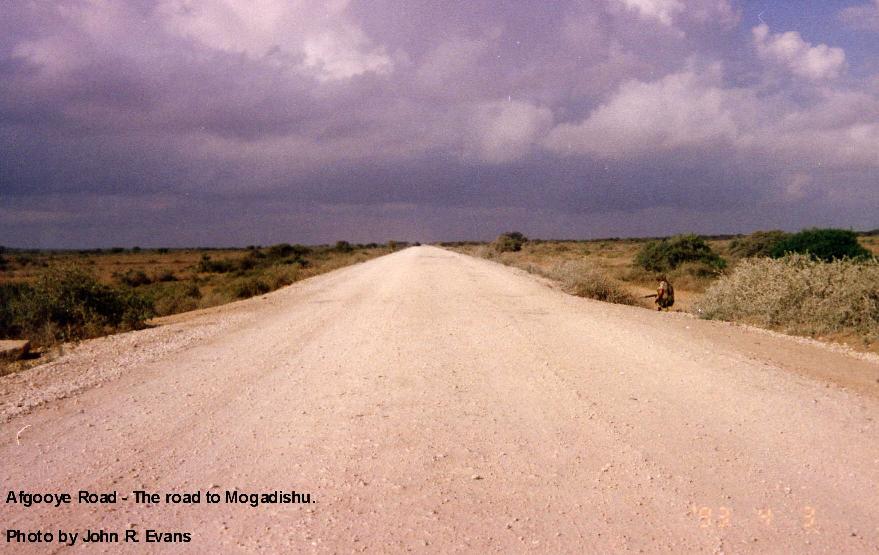
Regular from 1-22 IN down low & at the ready by the
Afgooye Road
Combat Operations
(The First Battles of Mogadishu)
A day that will be remembered in history is 5 June 1993. It began with a search and attack mission with the Belgian battalion as planned the previous day and night. The search and attack mission ended abruptly in the early afternoon with a flash radio message from the brigade TAC to the battalion TAC to return to the Kismayo airfield as soon as possible. An ambush of Pakistani forces had occurred in Mogadishu, and 1-22 Infantry (-) was to redeploy as quickly as possible back to the capital city as the situation there seemed grave.
Upon aborting the mission in Kismayo, the battalion TAC and the two companies redeployed to the airfield. Here, an unplanned but timely link-up was made with a Belgian C-130 that had just completed resupplying its detachment and was preparing to return to Mogadishu. It was immediately filled with as many soldiers as could fit into the space available. The flight took about an hour and landed by mid-afternoon at the Mogadishu International Airport. The northern side of the city was partially covered with smoke, as automobile tire blockades had been set ablaze in the vicinity of the ambush site.
The ambush of the Pakistani battalion had occurred on 21 October Road, which is the northernmost, east-west paved road in the city. They had been attacked by the Somali National Alliance (SNA) forces of Mohammad Farah Aidid who were upset that the UN had directed inspections of the Authorized Weapons Storage Sites (AWSS) located in the northern sections of the city. Shortly after the ambush, the brigade commander ordered the battalion’s remaining QRF company to respond to the ambush. Under the command of Captain Mike Robertson, Alpha company, the only unit from 1-22 Infantry that had not deployed to Kismayo, was ordered to deploy to the ambush area and develop the situation. Alpha company conducted security and force protection operations with the Pakistanis until the arrival of the battalion TAC and the additional infantry forces brought north from Kismayo.
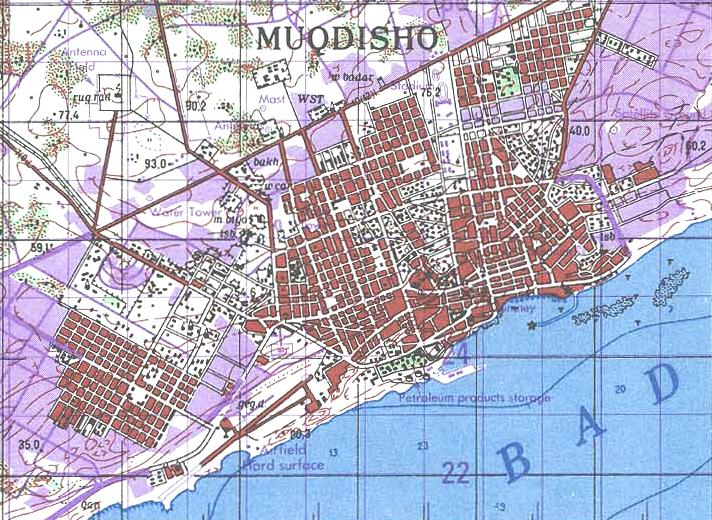
Map of downtown Mogadishu (Muodisho)
The battalion TAC and A Company link up occurred at approximately 1530 hours. For the rest of the afternoon and evening, elements of 1-22 Infantry secured and cleared the immediate area of Somali combatants and assisted the Pakistani battalion in evacuating from the ambush zone. These security and evacuation tasks included recovery and removal of the Pakistani dead and wounded that were still scattered in and around the ambush site. The battalion was then ordered to begin conducting additional search and attack patrolling missions in the northern neighborhoods of the city, looking for those Somali forces that prosecuted the ambush. There were no additional engagements or casualties after the additional search and attack patrolling mission. The TAC received a final change of mission for that day at approximately 2000 hours when the brigade headquarters radioed to return to base at the university compound.
In his book Seeking Peace from Chaos: Humanitarian Intervention in Somalia, Samuel M. Makinda outlined the casualty figures for 5 June 1993 as twenty-four Pakistani soldiers killed in action. LTC Martinez (1-22 CO) also recalls that eight Somali gunmen and their weapons were captured and that 1-22 Infantry had not taken any battle casualties. Somali casualties for the day were unknown. The day’s events were vitally important for 1-22 Infantry as the full focus of the battalion and brigade Task Force changed within one afternoon. The mission had transformed well beyond just a humanitarian mission. The UN headquarters began to plan for offensive combat action in retaliation for the attack of 5 June 1993. This would be the first direct use of offensive force by a UN headquarters command since the Korean War. The main force to execute those missions fell squarely on the First Brigade Combat Team, the only remaining 10th Mountain unit left in Somalia.
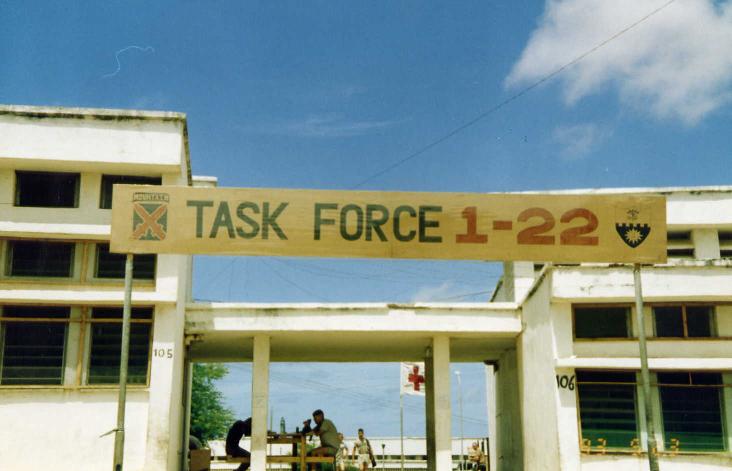
Regular Base ---- Mogadishu
Offensive Combat Operations
D-Day for the first set of UN attacks against the SNA was 12 June 1993. The attacks were composed of three specific target sets. The first target was the SNA-controlled radio station and its relay location. This target was designated as OBJ A4. The station had been increasing its anti-UN and anti-U.S. propaganda for some time prior to the 5 June ambush. The purpose of making the station a target was twofold: the first was to destroy the downtown radio station, and the second was to gain simultaneous control of the relay station so it could be used to transmit a less-aggressive message to the population in Mogadishu. AC-130 gunships were to hit the downtown station while A/1-22 Infantry (nicknamed “Attack” Company) would conduct a combat air assault to seize the relay station. The other two target sites were AWSSs that had been overtaken by Somali gunmen. The first AWSS was to be completely destroyed by AC-130 and Cobra gun ships. This was the storage site that contained the heaviest armor, including M60 tanks. The site was located about one kilometer north of 21 October Road and was designated OBJ A3. The last target site was also an AWSS. It was the sister site to OBJ A3 and was located just off of the north side of 21 October road in the vicinity of the cigarette factory. It was designated as OBJ A1. B/1-22 Infantry (nicknamed “Battle” Company) would conduct a ground movement from the University Compound north on Afgoyee road, turn east on 21 October road, dismount, deploy, then seize and secure the AWSS.
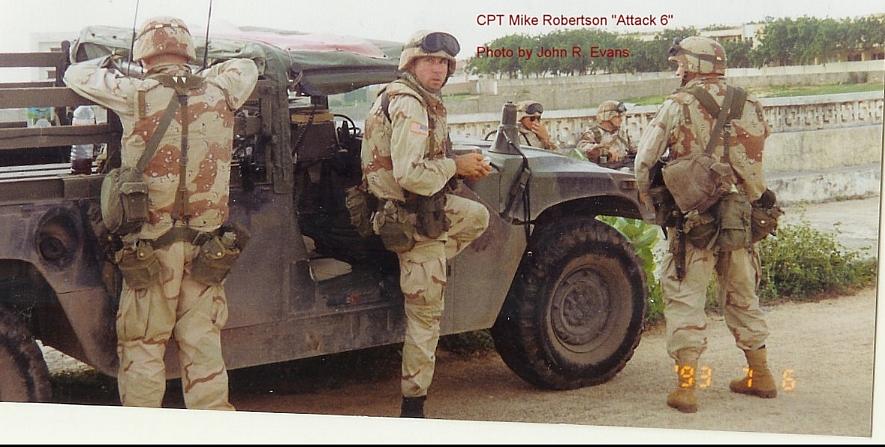
Captain Mike Robertson, Commander of A (Attack) Company
1-22 IN
The battalion commander designated two separate TACs to deploy with each of the companies. The first TAC, with the battalion S3, would air assault in with Attack Company to provide direct command and control (C2) while the actual battalion TAC would move via ground to provide C2 for both operations. The mission kicked off at 0350 with the gunships attacking first, followed by the A Company air assault at 0400 into objective A4. The combat air assault went off well. It resulted in seizing and securing the relay station with one enemy KIA and 38 captured. Simultaneous with the A4 attack, B Company and the battalion TAC crossed the start point (SP) and began the ground move from the compound to OBJ A1. As the ground convoy turned east onto 21 October Road, Somali gunmen executed an “L” shaped ambush using the wall that lined the south side of the Afgoyee and 21 October Roads as protection. A brief but intense firefight ensued resulting in 5 casualties inflicted on the gunmen (two KIA, three captured). Quickly the ground convoy got back under way towards the objective. The attack into OBJ A1 was further delayed as B Company and the TAC had to wait to enter the compound because ordnance in the AWSS from the earlier gunship attack was still exploding. The objective was secured with light resistance. Four tons of weapons and ammunition stored there were gathered together and blown in place by explosive ordnance detachment (EOD) personnel.
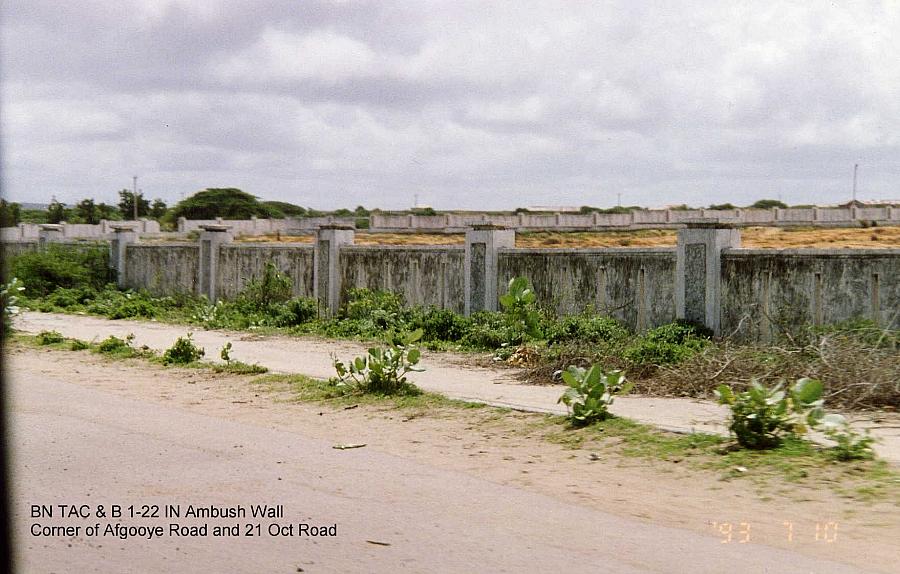
Scene of Somali ambush of 1-22 IN
**********************
Text and photos are copyright © John R. Evans 2005
Home | Photos | Battles & History | Current |
Rosters & Reports | Medal of Honor | Killed
in Action |
Personnel Locator | Commanders | Station
List | Campaigns |
Honors | Insignia & Memorabilia | 4-42
Artillery | Taps |
What's New | Editorial | Links |